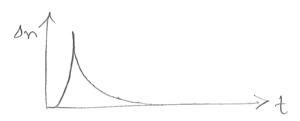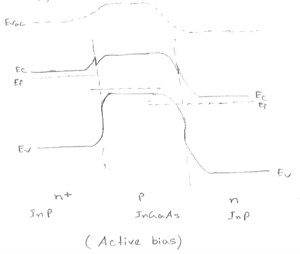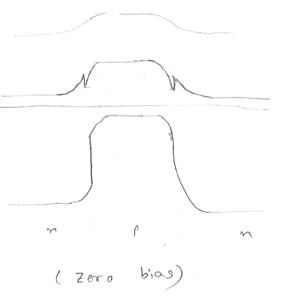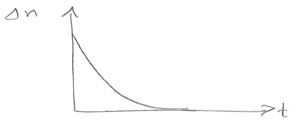(Created page with "Category:ECE Category:QE Category:MN Category:problem solving Category:Dynamics <center> <font size= 4> ECE_PhD_Qualifying_Exams|ECE Ph.D. Qualifying Ex...") |
|||
| (One intermediate revision by the same user not shown) | |||
| Line 16: | Line 16: | ||
</font size> | </font size> | ||
| − | August | + | August 2013 |
</center> | </center> | ||
---- | ---- | ||
---- | ---- | ||
==Questions== | ==Questions== | ||
| − | All questions are in this [https://engineering.purdue.edu/ECE/Academics/Graduates/ | + | All questions are in this [https://engineering.purdue.edu/ECE/Academics/Graduates/Archived_QE_August_13/MN-2%20QE%2013.pdf link] |
=Solutions of all questions= | =Solutions of all questions= | ||
| − | 1) | + | 1) Two effects: |
| − | + | i) Kirk effect or base pushout | |
| + | ii) Current crowding | ||
| − | + | ------------------------------------------------------------------------------------ | |
| + | 2) <math>Eg(InP) > Eg(InGaAs)</math> | ||
| − | + | So; InP is in emitter and collector. | |
| − | + | [[Image:MN2_2013_1.png|Alt text|300x300px]] | |
| − | + | ||
| − | + | [[Image:MN2_2013_2.png|Alt text|300x300px]] | |
| − | + | * <math>\beta</math> increases as: | |
| + | <math> | ||
\begin{align*} | \begin{align*} | ||
| − | \ | + | \beta &=\frac{D_n}{D_p}\cdot\frac{W_E}{W_B}\cdot\frac{n_{iB}^2}{n_{iE}^2}\cdot\frac{B_E}{N_B}\\ |
| − | \ | + | &\approx\frac{n_{iB}^2}{n_{iE}^2}\cdot\frac{B_E}{N_B}\cdot\frac{V_{th}}{v_s} |
| − | &\ | + | |
| − | + | ||
| − | + | ||
\end{align*} | \end{align*} | ||
</math> | </math> | ||
| + | <math> | ||
| + | \frac{n_{iB}^2}{n_{iE}^2} = e^{\triangle Eg/kT} | ||
| + | </math> | ||
| + | ; So huge improvement | ||
| − | + | ||
| − | 2 | + | * <math>V_{cb,br}</math> increases as <math>V_{cb,br}\approx\frac{3}{2}</math> Eg collector |
| + | |||
| + | |||
| + | * <math>f_{max}</math> increases | ||
<math> | <math> | ||
| + | f_{max}^{-1}\approx f_T^{-1} = \bigg(\frac{w_B^2}{2D_n}+\frac{w_{BC}}{2v_{sat}}\bigg)+\frac{kT}{qSe}[C_{jBC}+C_{jBE}] | ||
| + | </math> | ||
| + | here; <math>w_B\downarrow I_C\uparrow C_J\downarrow</math> all leads to <math>f_T\uparrow</math> | ||
| + | |||
| + | |||
| + | * high current effect reduces | ||
| + | |||
| + | |||
| + | * <math>V_cesat</math> (??) | ||
| + | |||
| + | ------------------------------------------------------------------------------------ | ||
| + | |||
| + | 3)a)<math> | ||
\begin{align*} | \begin{align*} | ||
| − | + | V_a&=0\\ | |
| − | + | \therefore E&=0 | |
| − | + | ||
| − | + | ||
\end{align*} | \end{align*} | ||
</math> | </math> | ||
| − | + | <math> | |
| − | + | \therefore n_p(x,t) = \frac{N}{\sqrt{4\pi D_nt}}exp\bigg(\frac{-x^2}{4D_nt}-\frac{t}{\tau_n}\bigg)+n_{p0} | |
| − | + | ||
| − | + | ||
| − | + | ||
| − | \ | + | |
</math> | </math> | ||
| + | At <math>x=0</math> | ||
| − | + | [[Image:MN2_2013_3.png|Alt text|300x300px]] | |
| − | + | ||
| − | + | ||
| − | + | ||
| − | + | ||
| − | + | ||
| − | + | ||
| − | + | ||
| − | + | ||
| − | + | ||
| − | + | ||
| − | + | ||
| − | + | ||
| − | + | ||
| − | + | ||
| − | + | ||
| − | + | ||
| − | + | ||
| − | + | ||
| − | + | ||
| − | + | ||
| − | + | ||
| − | + | 2 unknowns <math>\to D_n,\tau_n</math> selecting 2 specific times and using the excess carrier can find <math>D_n</math> and <math>\tau_n</math>. | |
| − | + | ||
| − | + | ||
| − | \ | + | |
| − | </math> | + | |
| − | + | At <math>x=X</math>; initially no excess carrier. | |
| − | + | [[Image:MN2_2013_4.png|Alt text|300x300px]] | |
| + | |||
| + | b) For applied field; decay will be much quicker. | ||
| + | |||
| + | ------------------------------------------------------------------------------------ | ||
---- | ---- | ||
[[ECE_PhD_Qualifying_Exams|Back to ECE Qualifying Exams (QE) page]] | [[ECE_PhD_Qualifying_Exams|Back to ECE Qualifying Exams (QE) page]] | ||
Latest revision as of 21:22, 5 August 2017
MICROELECTRONICS and NANOTECHNOLOGY (MN)
Question 2: Junction Devices
August 2013
Questions
All questions are in this link
Solutions of all questions
1) Two effects: i) Kirk effect or base pushout ii) Current crowding
------------------------------------------------------------------------------------
2) $ Eg(InP) > Eg(InGaAs) $
So; InP is in emitter and collector.
- $ \beta $ increases as:
$ \begin{align*} \beta &=\frac{D_n}{D_p}\cdot\frac{W_E}{W_B}\cdot\frac{n_{iB}^2}{n_{iE}^2}\cdot\frac{B_E}{N_B}\\ &\approx\frac{n_{iB}^2}{n_{iE}^2}\cdot\frac{B_E}{N_B}\cdot\frac{V_{th}}{v_s} \end{align*} $ $ \frac{n_{iB}^2}{n_{iE}^2} = e^{\triangle Eg/kT} $
- So huge improvement
- $ V_{cb,br} $ increases as $ V_{cb,br}\approx\frac{3}{2} $ Eg collector
- $ f_{max} $ increases
$ f_{max}^{-1}\approx f_T^{-1} = \bigg(\frac{w_B^2}{2D_n}+\frac{w_{BC}}{2v_{sat}}\bigg)+\frac{kT}{qSe}[C_{jBC}+C_{jBE}] $ here; $ w_B\downarrow I_C\uparrow C_J\downarrow $ all leads to $ f_T\uparrow $
- high current effect reduces
- $ V_cesat $ (??)
------------------------------------------------------------------------------------
3)a)$ \begin{align*} V_a&=0\\ \therefore E&=0 \end{align*} $
$ \therefore n_p(x,t) = \frac{N}{\sqrt{4\pi D_nt}}exp\bigg(\frac{-x^2}{4D_nt}-\frac{t}{\tau_n}\bigg)+n_{p0} $
At $ x=0 $
2 unknowns $ \to D_n,\tau_n $ selecting 2 specific times and using the excess carrier can find $ D_n $ and $ \tau_n $.
At $ x=X $; initially no excess carrier.

b) For applied field; decay will be much quicker.
------------------------------------------------------------------------------------




